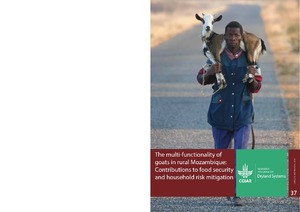The Mara-Serengeti Ecosystem and Greater Maasailand: Building the Role of Local Leaders, Institutions, and Communities
Much of the effort to include communities in conservation of large
landscapes has been driven by interests outside the savannas, either by national
governments, NGOs, or foreign conservationists (Neumann 2002,
Brockington et al. 2008). Once included in conservation planning only as
an afterthought, local communities are now major stakeholders. However,
initiatives driven, led, and managed by local leaders, communities, and institutions
to meet the needs of both wildlife and people remain rare. The
The multi-functionality of goats in rural Mozambique: Contributions to food security and household risk mitigation
It is widely acknowledged that goats in developing countries fulfill multiple functions and can contribute to improved livelihoods of smallholders. The multi-functionality of goats in rural Mozambique however is fairly unknown. The objective of the paper is therefore to identify and create a deeper understanding of the multiple functions goats currently play in the smallholders sector in Mozambique. The paper takes a sociological approach by advancing the thinking that the functions of goats are socially and culturally constructed, and not ‘given’.
The scientific basis of climate-smart agriculture: A systematic review protocol
Background: ‘Climate-smart agriculture’ (CSA)—agriculture and food systems that
sustainably increase food production, improve resilience (or adaptive capacity) of farming
systems, and mitigate climate change when possible—has quickly been integrated into the
global development agenda. However, the empirical evidence base for CSA has not been
assembled, complicating the transition from CSA concept to concrete actions, and
contributing to ideological disagreement among development practitioners. Thus, there is an
The Tribe - Platform of participatory local development and management of communal rangeland resources
Sustainable development of pastoral and agro-pastoral systems, dominated by collective and/or tribal ownership of rangelands, is a key issue for the West Asia and North Africa region. These two systems are located in arid and semi-arid areas and are increasingly threatened by desertification process. The policy responses to tackle this complexity have been a sectorial and fragmented, “top-down” approach, putting forward technical solutions and neglecting the social context.
The yield gap: closing the gap by widening the approach
The yield gap has arisen again as a focus for agricultural research to ensure food security and economic growth for farmers around the world. To examine this renewed interest, we carried out a review of key literature in the field of yield gap analysis to identify important gaps in research and analysis. In so doing, both the complexities in yield gap studies emerged along with some significant omissions. Much of the literature and research on the yield gap has been framed by larger concerns and initiatives to raise agricultural productivity.
Total value of phosphorus recovery
Phosphorus (P) is a critical, geographically concentrated, nonrenewable resource necessary to support global food production. In excess (e.g., due to runoff or wastewater discharges), P is also a primary cause of eutrophication. To reconcile the simultaneous shortage and overabundance of P, lost P flows must be recovered and reused, alongside improvements in P-use efficiency. While this motivation is increasingly being recognized, little P recovery is practiced today, as recovered P generally cannot compete with the relatively low cost of mined P.
Transforming the global landscape
Rapid land transformation driven by large scale investments is one of the big trends defining this century. In a virtual briefing for the Global Donor Platform members CIAT agriculture expert Deborah Bossio dismisses the cry for more investments often heard in development circles. From her perspective a lack of investments is not the problem. The more pressing question is whether these large scale investments could be sustainable and socially inclusive. How are they going to play out in the end?
Transitions in agro-pastoralist systems of East Africa: Impacts on food security and poverty
Climate-induced livelihood transitions in the agricultural systems of Africa are increasingly likely. There is limited evidence on what such transitions might look like. We carried out fieldwork in 12 sites in Kenya, Tanzania and Uganda to understand changes in farming systems in the recent past, and to test the hypothesis that sedentary farmers in zones that may become warmer and drier in the future may be forced to increase their reliance on livestock vis-à-vis cropping in the future. We estimated the contribution of crop and livestock activities to incomes, food security and poverty.
Trends and Outlook: Agricultural Water Management in southern Africa. Country report - South Africa. [Project report submitted to United States Agency for International Development’s (USAID’s) Feed the Future Program].
Understanding the roles of forests and tree-based systems in food provision
Forests and other tree-based systems such as agroforestry contribute to food and nutritional security in myriad ways. Directly, trees provide a variety of healthy foods including fruits, leafy vegetables, nuts, seeds and edible oils that can diversify diets and address seasonal food and nutritional gaps. Forests are also sources of a wider range of edible plants and fungi, as well as bushmeat, fish and insects.









